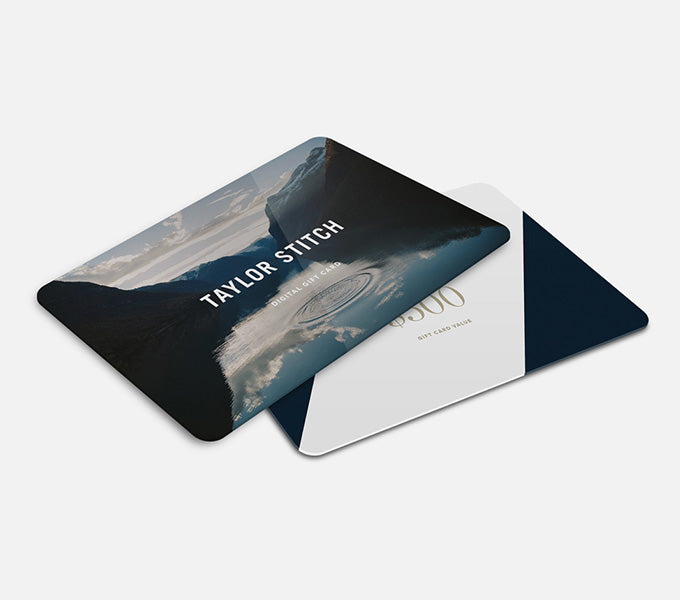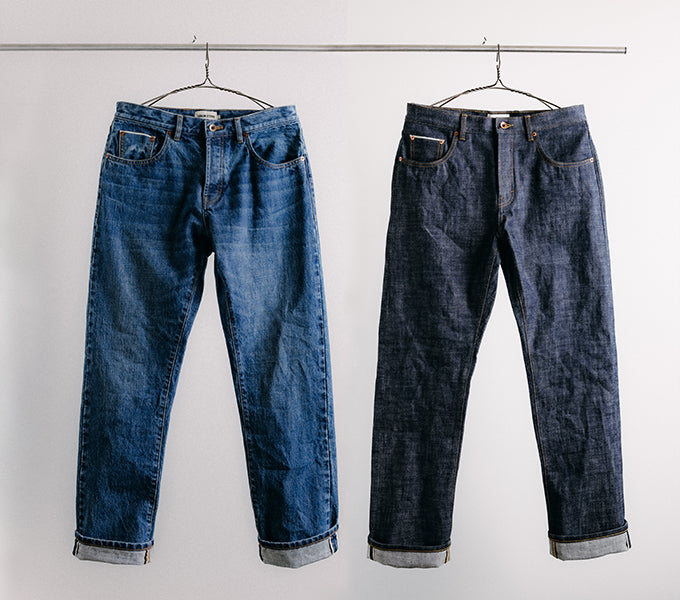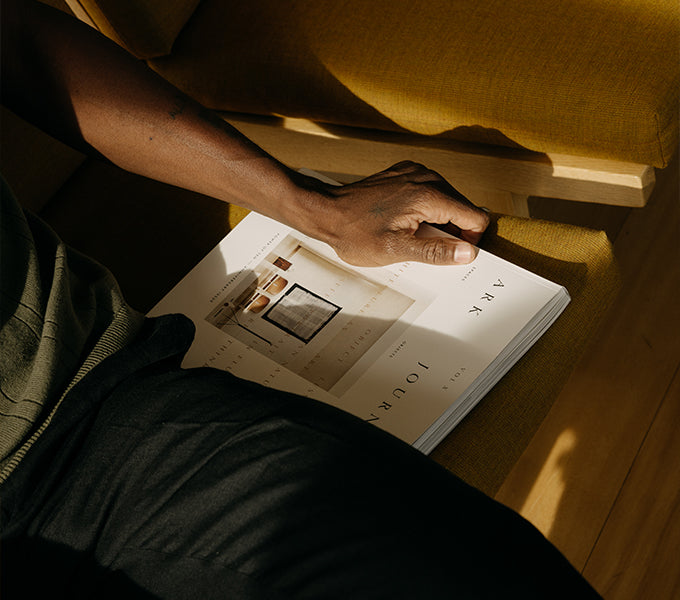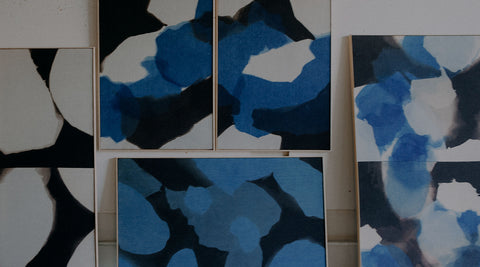Behind a windowed storefront in Fairfax, CA, is a long, bare concrete floor streaked with blue and black. Three huge pots bubble in active fermentation beneath a ceiling where linen panels hang on drying lines. It looks like something between a painter’s studio and the laboratory of a mad scientist. This is where artist Carrie Crawford works. This is Mineral Workshop.
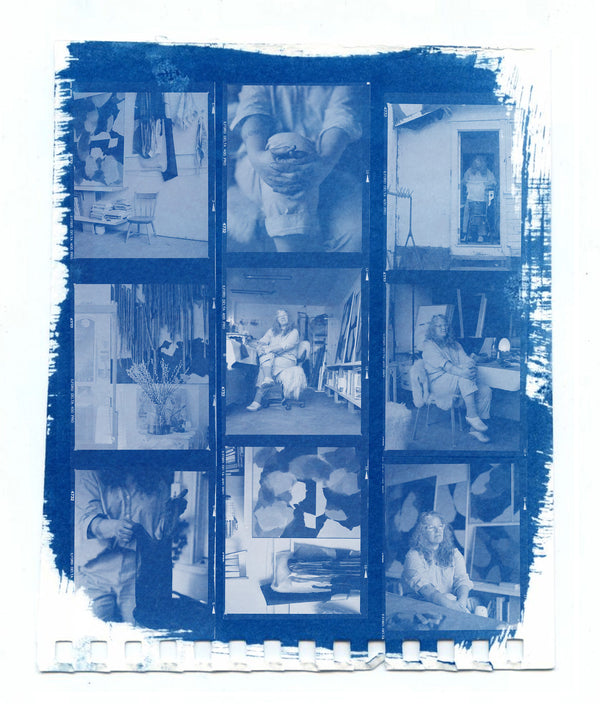
Here, Crawford uses painstaking methods to render pigments from natural materials. For her black dye, she crushes acorns and oak gales collected from the area, and her deep blues are wrested from the verdant leaves of the Indigofera plant.
Carrie’s oldest indigo pot is three years old, and, like a sourdough starter, she periodically feeds it with a combination of simple fruit sugars. While some artists buy their paints, Carrie’s materials are the outcome of a kind of alchemy. They are more than a means to an end; they are a living component of her art.

Finding a middle ground between a painterly style and graphic gusto, Carries’ dye-work is a meditation on the intersection of the man-made and the natural. With natural cloth and dyes, she draws earth minerals into a kind of free-flowing coalescence. A collision of colors and textures that celebrates the essential character of its elements while culminating in a single, harmonious work.
Our collaboration with Carrie celebrates her dye art in a limited run of shirting and outerwear. Each piece is crafted to wear-in beautifully over time, picking up unique fades with each passing year.
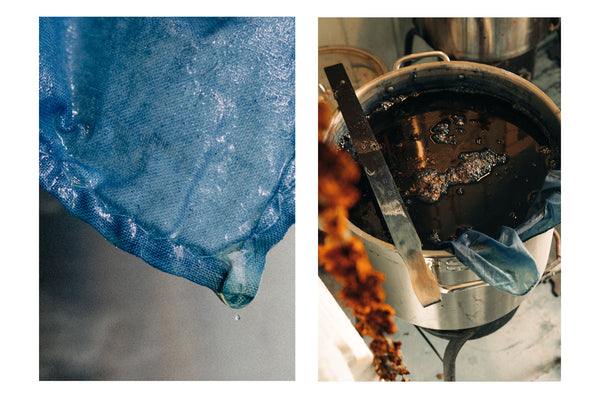
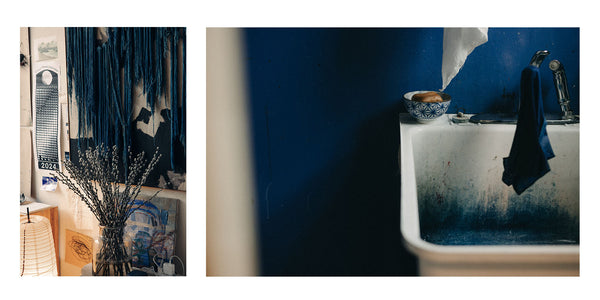
We sat down with Carrie to discuss her work, her inspirations, and what she’s looking forward to on the horizon. Here’s what she had to say.
What drew you to the medium of cloth and dye?
I am a bonafide textile nerd and lover of fibers. I find true joy in the infinite possibilities of plants, for both fiber and color, so an art practice that puts these materials at the center has completely captured my heart. After training in surface design, I was sadly met with the realities of the industry being dominated by digital work and not the painting and weaving I was so enthralled with. I took a weekend indigo dye workshop and was immediately soothed by the involved process of coaxing color from the plant. I knew I needed to be with my hands and the plants, not the screens.
How has your style and process evolved over the years?
The biggest evolution has been in my attitude around creating. In the early years I was really determined to make certain things appear, a hard line here or a certain shape there. I was really imposing my will and it was rigid and full of disappointments. Over time I realized that what really yielded work that resonated with me and all the concepts I work with was allowing the dye and cloth to do what they do. I began to see my role as one of companion rather than commander. My interventions became responses to what was organically occurring. It felt best being in partnership with the materials. This shift ushered in ease and brought compositions forward that were beyond what I thought possible. This was an unlock that joined the processes of natural dyeing to the concepts that make up my worldview and values. Once I got quiet and humble, there was magic.
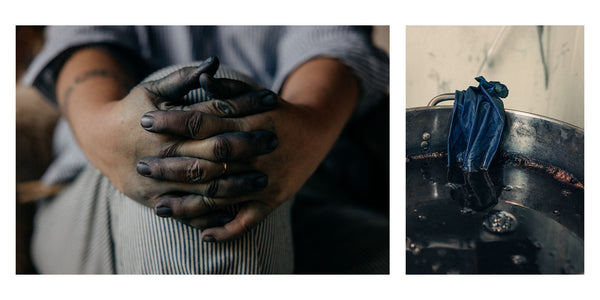

Having lived in Montana and now Marin County (both beautiful locales), how would you say your environment plays a role in your artwork?
Oh gosh, environment is everything. Growing up in Southern California, my mom always mused about Saddleback Peak. It was the compass rose of my youth. All directions and references were in relation to that high point. I think that way of orienting really imprinted on me, as I continue to ground myself with the land wherever I am.
I love a grand vista and mountain ridgetops and I love a stream bed and the soil level minutiae. Most simply, I find the natural world holds a grounding juxtaposition of calm while never ceasing to be wild. Be it lush or barren, green forests and dry golden grasslands, tranquil bay and open ocean, I love natural settings where disparate conditions and the edges between them exist with reciprocity, with danger and harmony, giving and taking. I am always looking to the earth for soothing beauty and a longer arc of meaning, anything to give this busy mind a tether to something old and wise and beyond comprehension.
I was fortunate to spend a decade in Montana, where the peaks were endless and the vistas breathtaking. Lots of biking, lots of hiking, lots of skiing. I recall winter days hiking out of bounds at the local ski area to the top of the ridge and seeing 3 different mountain ranges and sweeping valleys between…unbelievably beautiful ribbons of rivers and so many features and microclimates. And now, another decade-plus in California, I am in daily contact with redwood trees and bay/ocean confluences. I am particularly smitten with Tomales Bay.
What is the most challenging aspect of working with earth elements and natural fibers?
The big challenge is perhaps something we can all relate to when we unplug and downshift to analog processes…its slow work. There are many steps. There is a lot waiting for things to set up, to saturate, settle, to cure, to dry. I spend a lot of time with each piece, just looking and allowing that time to inform my next moves. So the challenge is really a blessing. I get to drop in: drop into quiet, drop into a way of making and being that nurtures! The pace of making this art is in high contrast to the world outside my door and inside me a lot of the time, honestly. This practice feels pretty sacred.
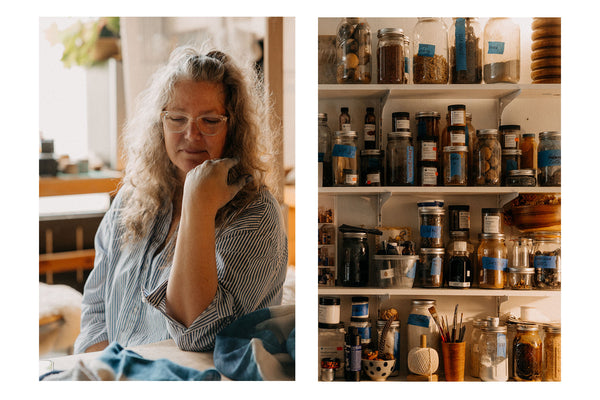
You’ve mentioned your fondness for aerial photography and mid-century artwork. How have they influenced your own work?
Years ago I was really moved when looking at some aerial photos of human-made natural disasters. The oil spills, the factory effluent streams, open pit mines…incredibly evocative visually. Like really, really beautiful and so so tragic, how can that be? I felt the dialectic of holding the horror with the beauty as something deeply familiar. I thought about how complex it is living in this world and in these bodies of ours…a complexity that I wanted to explore and welcome.
This inquiry lovingly crashes into the celebration of natural materials and clean lines of modernism, the impulse to make meaning of complexity by highlighting the intrinsic beauty, the form beneath the form, if you will. So, the moment of modernism captured in mid-century is like a great feast of texture and natural materials, simplicity, and honesty. The lines are clean to allow the poetry of the materials to sing… I like that. I like the edges where different sensibilities come together and make a new thing, a new space, a new idea.
What’s next for you?
I recently started hand-weaving very simplistic panels to layer on dyed grounds. I have been wanting to bring more physical texture to my work, and something about making the actual cloth gives life to many of the ideas I hover around. I hope to remain in this wonderland of plant materials and discoveries until the very end of time. I hope to continue to meet other fiber nerds and kindred folks. I hope to have busy hands, an open mind, and a soft heart.
Working with Carrie Crawford has been, above all, inspiring, and the resulting collection is truly something special. These pieces will have a place on our studio wall (and in our wardrobes) for a long time to come. We hope you love them as much as we do.

